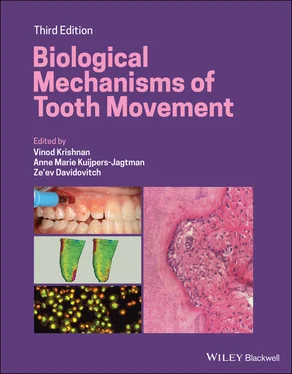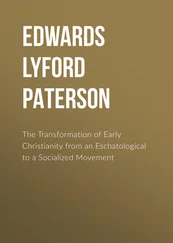94 Yamaguchi, M. (2009) RANK/RANKL/OPG during orthodontic tooth movement. Orthodontics and Craniofacial Research 12(2), 113–119. doi:10.1111/j.1601‐6343.2009.01444.x.
95 Yamaguchi M., Nakajima R. and Kasai K. (2012) Mechanoreceptors, nociceptors, and orthodontic tooth movement. Seminars in Orthodontics 18(4), 249–256. doi.org/10.1053/j.sodo.2012.06.003.
96 Yamamoto, T., Hasegawa, T., Yamamoto, T. et al. (2016) Histology of human cementum: Its structure, function and development. Japanese Dental Science Review 52(3), 63–74. doi:10.1016/j.jdsr.2016.04.002.
97 Yoshida, Y., Sasaki, T., Yokoya, K. et al. (1999) Cellular roles in relapse processes of experimentally‐moved rat molars. Journal of Electron Microscopy 48(2), 147–157. doi:10.1093/oxfordjournals.jmicro.a023661.
CHAPTER 4 Inflammatory Response in the Periodontal Ligament and Dental Pulp During Orthodontic Tooth Movement
Masaru Yamaguchi and Gustavo Pompermaier Garlet
Orthodontic tooth movement is induced by mechanical stimuli and facilitated by remodeling of the periodontal ligament and alveolar bone. A precondition for these remodeling activities, and ultimately for tooth displacement, is the occurrence of an inflammatory process in the periodontium and dental pulp, in response to the mechanical damage caused by orthodontic forces. Recent data suggests that cellular/tissue stress or damage‐related products, such as damage‐associated molecular pattern molecules, can trigger an aseptic inflammatory response. Vascular and cellular changes were the first events to be recognized and described, and a number of inflammatory mediators of immune and neural origin, such as cytokines, growth factors, and neuropeptides have been demonstrated in the periodontal supporting tissues. Their increased levels during orthodontic tooth movement have led to the assumption that a network of interactions between cells producing these substances (i.e., nerve, immune, and endocrine system cells), regulate the biological responses that occur following the application of orthodontic forces. Peripheral nerve fibers and neurotransmitters are also involved in the inflammatory process and bone remodeling as evidenced by the presence of neurogenic inflammation‐related substances such as calcitonin gene regulated peptide and substance P, leading to increased vasodilation, increased microvasculature permeability, production of exudate, and increased proliferation of endothelial cells and fibroblasts. Inflammatory mediators of immunological origin, such as prostaglandins, interleukins (ILs; IL‐1, IL‐6, IL‐17) as well as cytokines of the tumor necrosis factor α superfamily, which includes the RANK/RANKL/osteoprotegerin system, are also described in the periodontal ligament and dental pulp in increased levels after orthodontic force application. Considering the importance of RANK, RANKL, and osteoprotegerin in physiological osteoclast formation, it is reasonable to propose that the RANKL/RANK/osteoprotegerin system plays an important role in orthodontic tooth movement. This chapter reviews current knowledge regarding the role of inflammation in the periodontal tissue reactions in response to orthodontic forces.
Orthodontic tooth movement (OTM) is induced by mechanical stimuli and facilitated by remodeling of the periodontal ligament (PDL) and alveolar bone. A precondition for these remodeling activities, and ultimately for tooth displacement, is the occurrence of an aseptic inflammatory process. Vascular and cellular changes were the first events to be recognized and described, and a number of inflammatory mediators, including cytokines and neuropeptides, have been demonstrated in periodontal supporting tissues. Their increased levels during OTM have led to the assumption that interactions between cells producing these substances, such as nerve, immune, and endocrine system cells, regulate the biological responses that occur following the application of orthodontic forces (Krishnan and Davidovitch, 2006a).
Mechanical stress evokes biochemical responses and structural changes in a variety of cell types in vivo and in vitro . The overall objective of many investigations has been to further the understanding of the mechanisms involved in converting molecular and/or mechanical stress to the cellular responses that result in tooth movement. The recent advances in the understanding of the mechanisms underlying so‐called aseptic inflammation, mediated by tissue damage products collectively denominated damage associated molecular pattern proteins (DAMPs), have provided a rationale for inflammatory response triggering after orthodontic force‐induced mechanical stress/damage (Chen and Nunez, 2010). In sites at which inflammation and tissue destruction have occurred, cells may communicate with one another through the interaction of cytokines and other related molecules. Thus it is important to elucidate completely the complex cytokine cascade flow associated with inflammation‐mediated tissue destruction at the molecular level (Davidovitch et al ., 1988), as well as the intricate molecular network where the simultaneous action and presence of several mediators can determine the outcome of the response to the orthodontic force. This chapter reviews current evidence regarding the role of inflammation in the periodontal tissue reactions in response to orthodontic force application.
Inflammation during tooth movement
Inflammation characteristically displays the clinical signs of redness, heat, swelling, pain, and associated loss of function. It may be caused by a number of factors, including bacterial infection, or chemical or mechanical irritation. Histological examination reveals that acute inflammation is characterized by vasodilatation and is accompanied by increased permeability of the microvasculature. This increased permeability, with additional signals that confer chemotaxis specificity (provided by a class of chemotactic cytokines, collectively called chemokines), allows the migration of cellular components of blood from the lumen of the vessels into the extracellular spaces within the surrounding tissue. Once in the tissue, the cells follow a chemotactic gradient generated by the interaction of chemokines with the extracellular matrix, directing their migratory process. The migration of the leukocytes from the blood vessel lumen is also accompanied by secretion of exudates from the capillaries. There are a number of biochemical substances known to mediate cell migration‐associated changes, such as histamine, leukotrienes, prostaglandins, cytokines, and chemokines.
An inflammatory response is essential in the remodeling of alveolar bone and PDL during OTM. Researchers have been able to demonstrate histological and vascular changes in the PDL, as well as in the alveolar bone following inflammation associated with orthodontic force application ( Table 4.1) (Storey, 1973; Kvinnsland et al ., 1989). Biological factors, such as different classes of cytokines, chemokines, neurotransmitters, and genes implicated in the process and its associated increase in periodontal tissues of mechanically stressed teeth have been identified (Vandevska‐Radunovic, 1999). At this point, it is didactically possible to consider some of these molecules as the molecular triggers of host response (i.e., the first mediators produced in response to mechanical stimulation/damage of cells and tissues), which will subsequently lead to the development of a cascade pathway, mediated by effector molecules (also called first messengers). The first messengers will continue, sustain and/or amplify the inflammatory response by means of second messengers’ activation, which will ultimately be responsible for the cellular/tissue response and/or outcome. Recent evidence points to endogenous molecules, collectively named DAMPs, as the potential molecular triggers of the inflammatory process after orthodontic force application. In this context, both mechanical distortion of PDL cells and blood flow alterations subsequent to orthodontic force application could trigger DAMPs release, which in turn would elicit the subsequent first to second messengers cascade that ultimately leads to inflammation development.
Читать дальше












